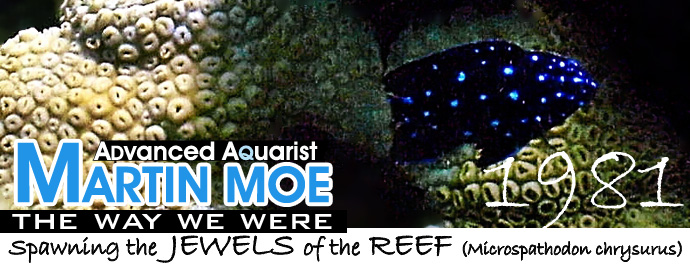
When a fishing guide takes you out and you don’t catch any fish, he may say “Gee, you should have been here last week, they were jumping into the boat.” Yeah, right. When a dive master takes you diving and you come up ask where the coral reef is, she may say, “Gee, you should have been here 40 years ago; it was healthy and beautiful with coral growth and tropical fish all over the place.” And so it was. And I was there also. Coral heads were massive, great stands of elkhorn coral reached for the surface and the shallow reefs were topped with extensive growths of fire coral, Millepora complanata. All of these corals had different species of fish and invertebrates that live to a greater or lesser extent within the special environment that that species of coral creates. Food, shelter, reproductive substrates-the coral provide the special environmental conditions that helped that species survive in the “eat or be eaten” world of a coral reef. And it was, and still is, one of the most wondrous environments on Earth.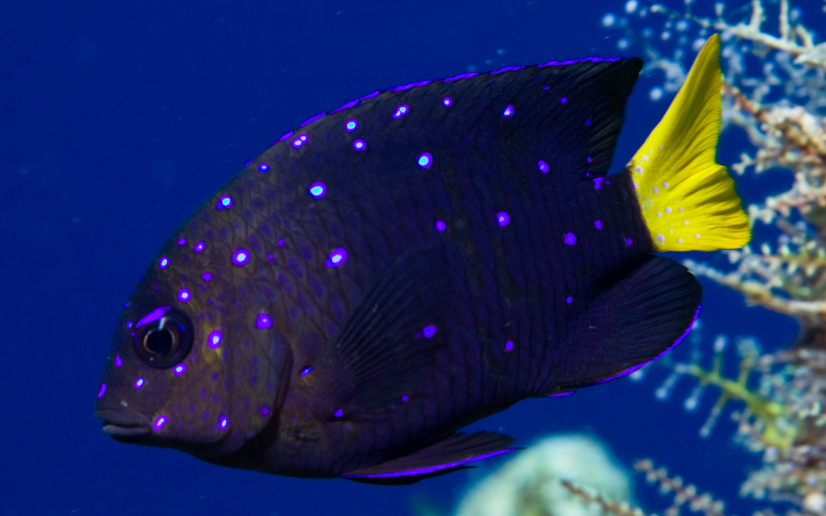
The company I started in 1973, Aqualife Research Corporation, moved to Marathon in the Florida Keys in late 1974 and I had the great opportunity to live, work, and dive in the Florida Key for ten years. Forrest joined me in, I think it was 1978, and we worked together until 1984 on the culture of clownfish, gobies, Atlantic angelfish, and many other species of reef fish, including the yellowtail reef fish, Microspathodon chrysurus. The juveniles of this species carried the common name of jewelfish at that time because of the brilliant iridescent blue spots that covered the body. These spots disappear as the fish attains the adult coloration of a drab dark brown body and bright yellow tail. Despite their aggressive nature, their constant movement and bright coloration made them a popular fish for marine aquariums at the time. They are a good species for reef tanks if kept one per tank.
Jewelfish lived in the fire coral reefs, they fed on algae and invertebrates that occupied these reefs, and they laid their eggs on the dead blades of the fire coral. In fact I seldom saw yellowtail reef fish except with a growth of fire coral, however small, right near them. I remember back in the mid 70s, I would hover at the edge of the fire coral reef and look over the relatively flat surface of the reef. After a while I would see male jewelfish in specific areas scattered widely over the reef popping up and flashing, dropping down into the reef and moments later popping back up, and repeating this behavior over and over again. They were tending to their nest of eggs on fire coral blades and trying to attract a female to stop by and drop off a few eggs, maybe 400 or so, to enlarge the nest that the male was tending and guarding.
I recall the first time I checked this out and found a large nest of eggs on a dead blade of fire coral. I hit the top of the blade breaking it off near the bottom. It was about 8 inches long and had more than a thousand eggs, the results of several spawns all over one side. I picked it and got very excited when I realized that I had in my hand potentially $50,000 worth of juvenile jewelfish, if I could only rear them. (But I knew then, as now, that flooding the market with one species, leads to very much lower prices and excessive unsold inventory.) But still it was certainly worth it to rear some of them.
There was considerable interest and competition in the very early days of marine fish culture and we played our cards pretty close to our vest in those days. Thus the article below from the May 1981 issue of Freshwater and Marine Aquarium Magazine (price $1.50) did not provide many details as to exactly how we reared them. But the secret was, of course, copepods from wild plankton as a first food. Suspending the blades of fire coral with their nests of jewelfish eggs in a large larvae rearing tank with a heavy flow from an air stone release underneath them was all it took to keep them alive during development and stimulate hatching when the embryos were ready.
Back in those days, rearing marine tropical fish was a quixotic exercise of producing an expensive cultured fish that competed with an inexpensive wild caught fish in a market that was highly price competitive. But still, the promise of what could be, and what would probably be, drove adventurous souls like Forrest and me to invest more of ourselves into a culture that really didn’t make a lot of economic sense at the time. But some dreams never die…
Unfortunately, however, the coral reefs, at least what they were in 1970s and early 80s, did die, or at least greatly diminish. Those vast expanses of fire coral that topped the reefs are gone, and so also the yellowtail reef fish and their stunningly beautiful jewelfish juveniles are now very hard to find. Florida’s coral reefs have declined for many reasons: pollution, storms, overfishing, over visitation, and disease of both corals and invertebrates. Perhaps the most critical loss of biodiversity was the almost total annihilation of the keystone herbivore of the Atlantic coral reefs, the long-spined sea urchin, Diadema antillarum, in a great plague that swept from the Panama Canal through this great oceanic region all the way to Bermuda in the space of 13 months in 1983. Within weeks macro algae began to overtake the Atlantic coral reefs and this is still the case today. These urchins have not recovered, their ecological function of herbivory is still absent and the reefs continue to decline. But now we can culture these difficult urchins, and after six years of effort I am close to completion of a functional technology for small scale urchin larvae culture, and I hope that this will stimulate more effort to restore this keystone herbivore to Atlantic coral reefs. Then perhaps the fire coral reefs and the jewelfish will return.
– Martin Moe
Spawning the Jewels of the Reef
Freshwater and Marine Aquarium magazine, May 1981
By Martin A. Moe & Forrest A. Young
Aqualife Research Corporation
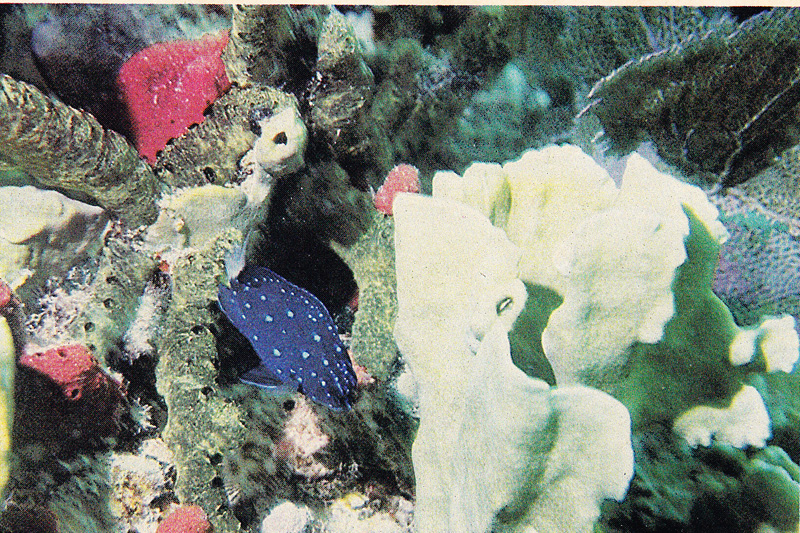
A juvenile jewelfish seeks protection from the photographer among the growths of fire corals and sponges. At 3 ½ months old the young jewelfish, in full possession of their electric blue gems, are ready to glorify an aquarists display.
The yellow-tailed damselfish, Microspathodon chrysurus, or marine jewelfish as it is known in the hobby, is one of the hardiest and most colorful of the Atlantic damselfish. Juveniles exhibit a striking coloration of iridescent neon blue spots against a midnight blue background. This fades in intensity as the fish matures and only a few small blue spots remain on the drab, dark brown adult. Also, the color of the caudal fin changes from clear in the juvenile to a bright yellow on the adult, hence the origin of the accepted common name.
In nature, adult and juvenile jewelfish arc found almost exclusively among the flat, branching growths of fire coral, principally Millepora complanata. The fire coral affords the jewelfish protection from predators, reproductive sites, and even food since stomach contents are composed of algae and detritus common to fire coral reefs as well as elements of the fire coral itself. Ciardelli (1967) examined stomach contents of juvenile jewelfish and found a variety of vegetable and animal matter including nematocysts (stinging cells) that apparently were from Millepora. He feels that the ingestion of fire coral by juvenile jewelfish may explain their close relationship with the shallow fire coral reefs. Unlike other damselfish in the same environment, Randall ( 1967) reports that jewelfish were never observed feeding on planktonic organisms, but restricted their diet to benthic algae with a small amount of animal matter. He also describes cleaning behavior, removal of ectoparasites by juvenile jewelfish from large grey angelfish. Emery (1968) reports that benthic animals are important in the diet of the juveniles, including coral polyps and sponge, and that adults gradually switch to almost exclusively benthic algae.
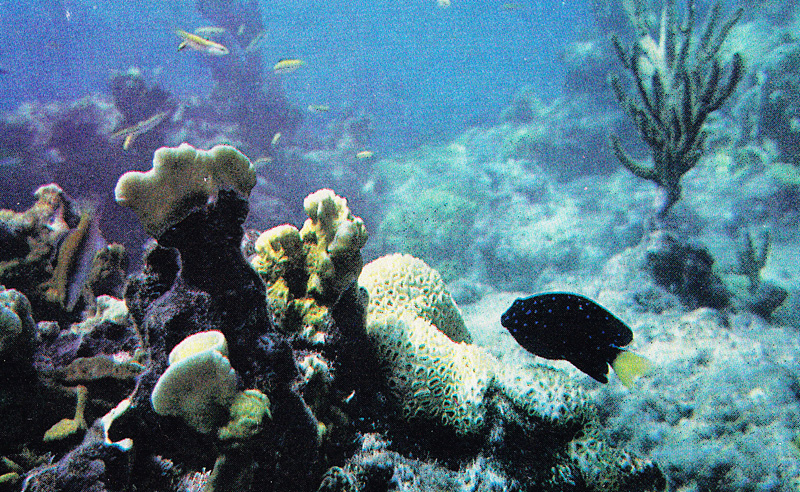
A male jewelfish keeps a watchful eye on the schools of wrasses that are quick to strip the nest of the unwary guardian.
The association of jewelfish with fire coral is so exclusive that we consider it a form of commensalism. This association is not as obvious as the spectacular commensalism of clownfish, Amphiprion sp., with anemones, but seems to be almost as obligate to the fish. It is extremely rare to find a jewelfish without at least a small growth of fire coral in the immediate environment. Further observation and ecological analysis of this association is needed to clarify the relationship between fire coral and jewelfish.
Jewelfish are beautiful and hardy and. although they are very aggressive toward others of their species, they are good solitary aquarium fish and are an excellent prospect for commercial culture.
Aqualife Research Corporation first reared jewelfish into large juveniles in mid 1976 and developed the techniques for large scale culture in late 1978. Almost 1000 individuals were reared in a single tank during this period, so tank reared jewelfish should soon be available to the hobby. Jewelfish, like other pomacentrids such as clownfish and damselfish, are demersal spawners and adhere their eggs to coral structures near the top of the reefs. Each species of damselfish has a particular place and substrate favored for nest building. Jewelfish eggs are much smaller than clownfish eggs and, like clownfish eggs, are attached at one end to the spawning site. The nests are composed of tiny, I mm diameter elliptical eggs densely packed on a coral substrate. There is an average of about 1,150 eggs per square inch of nest, and one nest with eggs in various stages of development may easily cover 20 to 80 square inches, a total of 23,000 to 92,000 jewelfish eggs on each spawning site. The eggs are translucent with a pinkish cast when newly laid and become darker as the embryo develops and hatching time approaches. The eyes are fully developed at hatching and are the most noticeable feature of the late stage embryo and early hatchling. The time from spawning to hatching is about 3 days at 80 F (27 C) and hatching usually occurs at night.
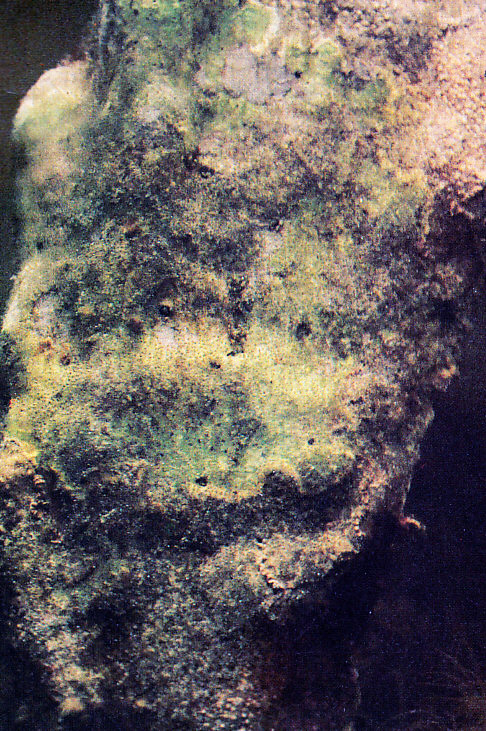
A blade of dead, fire coral, Millepora complanata, almost covered with eggs in various stages of development of the Atlantic Jewelffish, Microspathodon chrysurus. Tiny filamentous algae and jewelfish eggs cover the flat surface of the nest. The male guards the nest with vigor and few dare to incite his wrath by disturbing the nest.
The newly hatched larvae are so small, less than l/16″ long, and so slight and transparent that they are almost invisible. Those that peer into a tank of newly hatched jewelfish for the first time are incredulous that they cannot see a one of the 15,000 fish that are swimming about in the tank. However, a little searching soon reveals the presence of the diminutive larvae. One newspaper reporter was sure that he had drunk water with more critters in it than he could see in a tank of larval jewelfish.
Jewelfish larvae are much smaller than clownfish larvae and appear very similar to larval angelfish to the unpracticed eye. Some species of marine fish, such as the neon goby, metamorphose very quickly from larval to juvenile coloration and behavior patterns. This change to the juvenile characteristics occurs actually overnight in some instances, although most species require a few days to make the complete transformation. Other species, like the jewelfish, go through a prolonged period of gradual change and the juvenile characteristics are acquired very slowly. The post larval period is passed in the form of a creature adapted to the pelagic environment rather than one living secretively among the bottom growths.
The larval period for jewelfish extends to 4 weeks and the post larval period may take an additional 3 to 4 weeks before juvenile form and color are attained. The total length of the fish exceeds 1/2″ before the Post larval period is complete. The most obvious structural development of the larval jewelfish is the greatly enlarged pectoral fins. During this early period, the pectoral fins extend posteriorly to almost the caudal fin and spread outward a distance equal to about the depth of the body. These large laterally spread fins greatly increase the horizontal surface area of the fish, an adaptation that provides support and mobility in the pelagic environment. These pectoral fins are always spread and give the diminutive fish the appearance of flying through the water. ln fact, they look for all the world like miniature delta wing aircraft pursuing some important mission as they cruise tirelessly throughout the tank. They pause only to sight on and strike at food organisms.
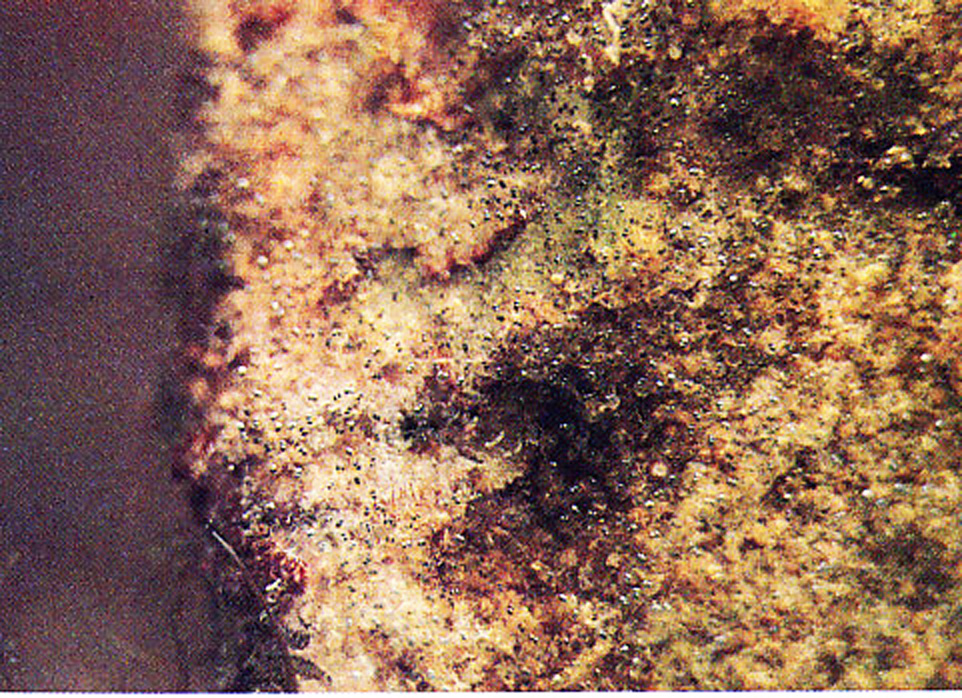
A close up of the sane nest. It reveals the bright silver eyes of the advanced embryos within the eggs. Hatching may take place at any time, although most usually at night.
There is a price that must be paid for this extraordinary larval mobility and restless behavior. Some other species, such as angelfish and reef drum, (jackknife fish) have slow moving sedentary larvae that seem to expend their energy only at the moment of striking at the prey organism. These larvae grow much faster than jewelfish and enter the benthic juvenile stage in only 2 to 3 weeks, less than half the larval period of jewelfish. Of course, tank reared marine fish larvae experience an unnatural environment and behavior and growth cannot be assumed to be exactly the same as wild fish, although parallels certainly exist.
Apparently, jewelfish require fire coral reefs for survival in the wild, and this type of habitat, while not at all a rare kind of reef formation; it still does not cover broad expanses like grass flats or the soft coral – hard rubble bottoms. A journey of many miles might be required of the tiny post larval fish before it encounters a fire coral formation. We consider it quite possible that the extensive pectoral fin development, active swimming mode, and the prolonged period of larval and post larval stages are adaptations that provide young jewelfish the means of finding the relatively restricted type of habitat required for survival. Jewelfish are distributed on fire coral reefs from Florida to Brazil and the extended duration and mobility of the early stages must enhance such wide distribution to a restricted habitat. The energy expended in the larval stage slows growth and prolongs the dangerous pelagic period, but these disadvantages are apparently compensated by the ability to find the fire coral reefs.
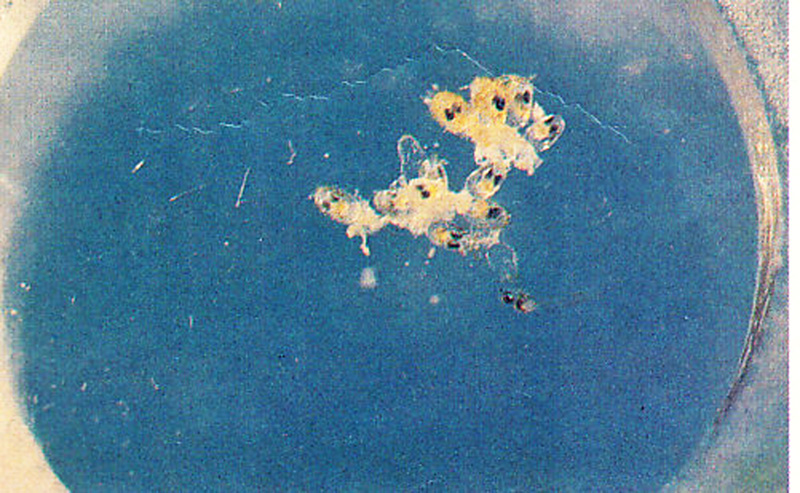
A very small part of the egg mass placed in a 15 mm diameter well slide shows a newly hatched larva beside its empty egg case. Other unhatched eggs are still attached.to the encrusting material from the surface of the nest. The yolk sac of the new hatched larva is still quite large indicating a probable premature hatch. Larvae with such large yolk sacs can still survive but do not begin feeding until the day after hatch.
As mentioned above, juvenile jewelfish feed mainly on sponge, algae, hydroids, isopods, and copepods so they adapt well to the typical aquarium diet. Since adults feed almost exclusively on benthic algae, a diet rich in vegetable matter is suggested as they mature. They take a wide variety of foods including live or frozen brine shrimp, flake foods and finely chopped shrimp.
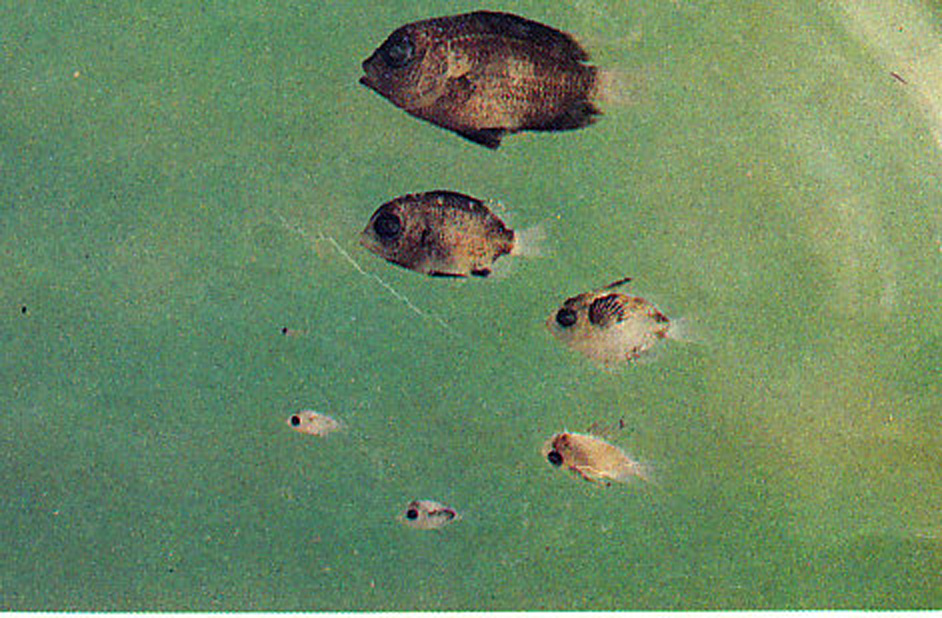
The developmental sequence of the Atlantic Jewelfish. The smallest larval form shown is already a week old and the post larval form at the 12 o’clock position is 35 days old. The juvenile at the top is a few days short of 8 weeks of age. Jewelfish have a long larval life, and although many eggs are laid, few survive in nature to the juvenile stage.
Jewelfish make an excellent addition to a community tank. They are impressively colorful, are very active and often engage in transport of stones and objects from their home area. They may also show cleaning behavior on the larger fish in the tank. Unless the tank is quite large, however, only one jewelfish should be kept per tank because they are highly territorial and eventually the dominant fish will destroy his few unfortunate brethren. Aggressiveness toward others of their kind is not restricted to jewelfish, although they are quite good at it. Many coral reef fish are strongly territorial and will drive cognates that compete for food and shelter away from their premises. The weaker fish is only too happy to flee and find his own piece of the rock, but containment in 4 glass walls with his adversary soon leads to his demise. On the other hand, the presence of many small fish of the same species in the same tank, in this case, jewelfish, seems to diffuse their aggression and 30, 50, 100 or more can coexist and grow in a relatively small contained area. Otherwise, they would be most difficult to rear in large numbers to aquarium size. Aqualife Research Corporation has already made a few shipments of tank reared jewelfish to various dealers and, hopefully, many more will be available in the near future.
References
- Ciardelli. A. 1967. The Anatomy of the Feeding Mechanism and the Food Habits of Microspathodon crysurus (Pisces: Pomacentridae). Bull. Of Marine Sci. Vol. 17. No. 4. PP 845-883.
- Emery. A.R. 1968. Comparative Ecology of Damselfishes (Pisces: Pomacentridae ) at Alligator Reef. Florida Kevs Dissertation, University of Miami. Coral Gables, Florida, 258 Pages.
- Randall, J. E., 1967, Food Habits of Reef Fishes of the West Indies. Studies in Tropical Oceanography, No.5. pp. 665-847.



0 Comments